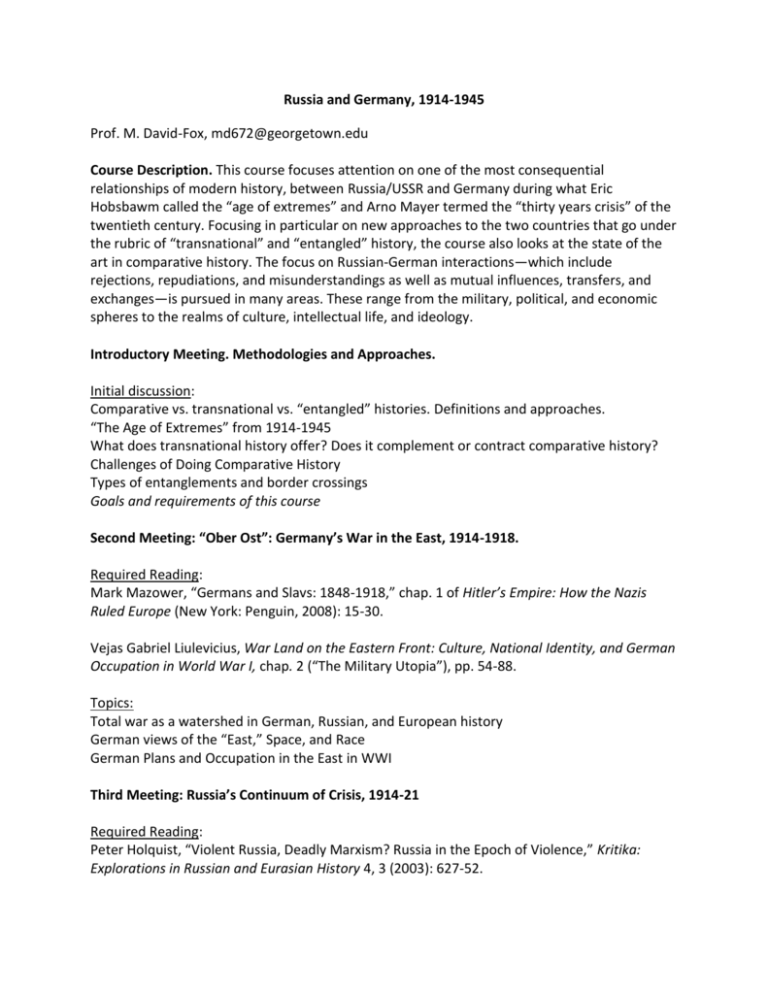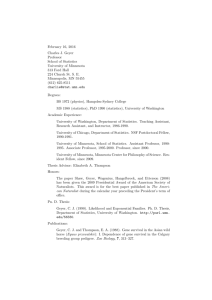Michael David-Fox, “Razmyshleniia o stalinizme, voine i nasilii,”
advertisement

Russia and Germany, 1914-1945 Prof. M. David-Fox, md672@georgetown.edu Course Description. This course focuses attention on one of the most consequential relationships of modern history, between Russia/USSR and Germany during what Eric Hobsbawm called the “age of extremes” and Arno Mayer termed the “thirty years crisis” of the twentieth century. Focusing in particular on new approaches to the two countries that go under the rubric of “transnational” and “entangled” history, the course also looks at the state of the art in comparative history. The focus on Russian-German interactions—which include rejections, repudiations, and misunderstandings as well as mutual influences, transfers, and exchanges—is pursued in many areas. These range from the military, political, and economic spheres to the realms of culture, intellectual life, and ideology. Introductory Meeting. Methodologies and Approaches. Initial discussion: Comparative vs. transnational vs. “entangled” histories. Definitions and approaches. “The Age of Extremes” from 1914-1945 What does transnational history offer? Does it complement or contract comparative history? Challenges of Doing Comparative History Types of entanglements and border crossings Goals and requirements of this course Second Meeting: “Ober Ost”: Germany’s War in the East, 1914-1918. Required Reading: Mark Mazower, “Germans and Slavs: 1848-1918,” chap. 1 of Hitler’s Empire: How the Nazis Ruled Europe (New York: Penguin, 2008): 15-30. Vejas Gabriel Liulevicius, War Land on the Eastern Front: Culture, National Identity, and German Occupation in World War I, chap. 2 (“The Military Utopia”), pp. 54-88. Topics: Total war as a watershed in German, Russian, and European history German views of the “East,” Space, and Race German Plans and Occupation in the East in WWI Third Meeting: Russia’s Continuum of Crisis, 1914-21 Required Reading: Peter Holquist, “Violent Russia, Deadly Marxism? Russia in the Epoch of Violence,” Kritika: Explorations in Russian and Eurasian History 4, 3 (2003): 627-52. Topics: 1914-21 as a Continuum of Crisis: Implications Russia’s Distinctiveness and Comparability in the Era of Total War Interconnections and Differences: 1917 and 1918 The German war economy (Kriegswirtschaft) and its influence on “War Communism” Fourth Meeting: Weimar/NEP: Cultural and Intellectual Exchange Required Reading: Michael David-Fox, “Leftists versus Nationalists in Soviet-Weimar Cultural Diplomacy: Showcases, Fronts, and Boomerangs,” in Susan Gross Solomon, ed., Doing Medicine Together: Germany and Russia between the Wars (Toronto: University of Toronto Press, 2006): 103-158. Topics: Weimar Germany and NEP Russia The Avant-Garde Travelers and Cultural Diplomacy The “Eastern Orientation” after Rapallo The German Far Right (“National Bolshevism”) and Soviet Communism Fifth Meeting: The Stalin Revolution and The Nazi Revolution: Political Systems and Ideologies Required Reading: Yorham Gorlizki and Hans Mommsen, “The Political (Dis)Orders of Stalinism and National Socialism,” in Beyond Totalitarianism: Stalinism and Nazism Compared, ed. Michael Geyer and Sheila Fitzpatrick (Cambridge: Cambridge University Press, 2009): 41-86. Peter Fritzsche and Jochen Hellbeck, “The New Man in Stalinist Russia and Nazi Germany,” in Beyond Totalitarianism: Stalinism and Nazism Compared, ed. Michael Geyer and Sheila Fitzpatrick (Cambridge: Cambridge University Press, 2009): 302-344. Topics: The Concept of Totalitarianism and its Critics The Comparison between Stalinism and National Socialism: Political Systems Class and Race: Ideologies, their Nature, their Impact Sixth Meeting: Population Politics and Social Engineering Required Reading: David L. Hoffmann and Anette F. Timm, “Utopian Biopolitics: Reproductive Policies, Gender Roles, and Sexuality in Nazi Germany and the Soviet Union,” in Beyond Totalitarianism: Stalinism and Nazism Compared, ed. Michael Geyer and Sheila Fitzpatrick (Cambridge: Cambridge University Press, 2009): Christopher Browning and Lewis Siegelbaum, “Frameworks for Social Engineering: Stalinist Schema of Identification and the Nazi Volksgemeinschaft,” in Beyond Totalitarianism: Stalinism and Nazism Compared, ed. Michael Geyer and Sheila Fitzpatrick (Cambridge: Cambridge University Press, 2009): 231-265. Topics: Internal and External Enemies: Theory and Practice Attempts to Create the New Society: Successes and Failures Social Policies and Social Engineering Seventh Meeting: Images of the Other Required Reading: Katerina Clark and Karl Schlögel, “Mutual Perceptions and Projections: Stalin’s Russia in Nazi Germany – Nazi Germany in the Soviet Union,” in Beyond Totalitarianism: Stalinism and Nazism Compared, ed. Michael Geyer and Sheila Fitzpatrick (Cambridge: Cambridge University Press, 2009): 396-441. Topics: “Judeo-Bolshevism,” Marxist-Leninist Understandings of Fascism Soviet and German Intellectuals The International Dimensions of Stalinist Culture German Emigration in the USSR; Pan-European Anti-Fascist Culture The Great Terror and Foreigners The Nazi-Soviet Pact Eighth Meeting: ‘Absolute’ War on the Eastern Front Required Reading: Mark Edele and Michael Geyer, “States of Exception: The Nazi-Soviet War as a System of Violence, 1939-1945,” in Beyond Totalitarianism: Stalinism and Nazism Compared, ed. Michael Geyer and Sheila Fitzpatrick (Cambridge: Cambridge University Press, 2009): 345-395. Michael David-Fox, “Razmyshleniia o stalinizme, voine i nasilii,” in Oleg Budnitskii and Liudmila Novikova, eds., SSSR vo Vtoroi mirovoi voine: Okkupatsiia. Kholokost. Stalinizm (Moscow: ROSSPEN, 2014): 176-195. Topics: German Plans and Occupied Territories Types of Violence, Escalations of Violence Soviet Depictions of the Holocaust and Nazi Atrocities Wartime Propaganda: Differences in Approach Re-Sovietization in Light of German Occupation/Colonization WWII as a Watershed in Soviet History Final Assignment: Submit a book review of one of the recommended readings below. Recommended Readings Vejas Gabriel Liulevicius, War Land on the Eastern Front: Culture, National Identity, and German Occupation in World War I (Cambridge: Cambridge University Press, 2000). Vejas Gabriel Liulevicius, The German Myth of the East: 1800 to the Present (Oxford: Oxford University Press, 2009). Герд Кёнен. Между страхом и восхищением. "Российский комплекс" в сознании немцев. 19001945 (М.: РОССПЭН, 2010). Оксана Нагорная, Другой военный опыт: русские военнопленные в Германии в период Первой мировой войны (1914-1922). (М.: Новый хронограф, 2010). Eric Lohr, Nationalizing the Russian Empire: The Campaign against Enemy Aliens during World War I (Cambridge: Harvard University Press, 2003), also in Russian. Peter Holquist, Making War, Forging Revolution: Russia's Continuum of Crisis, 1914-1921 (Cambridge: Harvard University Press, 2002) Annmarie H. Sammartino, The Impossible Border: Germany and the East, 1914-1922 (Ithaca: Cornell University Press, 2010). C. Журавлев, «Маленькие люди» и «большая история». Иностранцы московского Электрозавода в советском обществе 1920-1930-х гг. (М.: РОССПЭН, 2000). M. David-Fox et al., eds., Fascination and Enmity: Russia and Germany as Entangled Histories, 1914-1945 (Pittsburgh: University of Pittsburgh Press, 2012). Peter Fritzsche, Germans into Nazis (Cambridge: Harvard University Press, 1998). Peter Fritzsche, Life and Death in the Third Reich (Cambridge: Harvard University Press, 2008). Michael Wildt, An Uncomproming Generation: The Nazi Leadership of the Reich Security Main Office (Madison: University of Wisconsin Press, 2009), trans. of Generation des Unbedinkten. Карл Шлёгель, Берлин, Восточный вокзал. Русская эмиграция в Германии между двумя войнами (1919—1945). (М.: Новое литературное обозрение, 2004), translation of Berlin, Ostbahnhof Europas. Карл Шлёгель, Tеррор и мечта. Москва 1937 (М.: РОССПЭН, 2011 [История сталинизма]). Timothy Snyder, Bloodlands: Europe Between Hitler and Stalin (New York: Basic Books, 2010). Mark Mazower, Hitler’s Empire: How the Nazis Ruled Europe (New York: Penguin, 2008).




